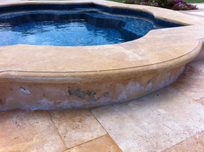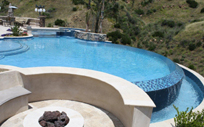Pools & Spas
The distinctive London Aquatics Centre for the 2012 Olympic Games will seat 17,500 spectators and boast two 50-meter swimming pools, one 25-meter diving pool and various training facilities. Competitions slated to take place in the center are
As part of their work in crafting custom pools for high-end clients in the Washington, D.C., area, Bill Bennett and Walt Williams are often called on to find creative solutions to substantial design challenges. For two recent indoor projects, for example, both clients wanted to be able to transform their indoor pool areas into dry spaces suitable for large gatherings – but they wanted to do it without resorting to either automatic solid covers or moveable floors. It was quite a coincidence: Within the span of just a few weeks, we at Alpine Pool & Design (Annandale, Va.) became involved in not one, but two highly unusual projects that offered us the exact same challenge. Both were indoor swimming pools for well-to-do clients living in the vicinity of our nation's capital. Both were rectangles, with each one situated beautifully within magnificent surroundings. Finally, both enabled us to work with our good friend and long-time professional associate Kevin Ruddy of Omega Pool Structures (Toms River, N.J.) Ruddy is something of a guru when it comes to indoor pools, and as builders as well as designers we appreciate the care and detail he puts into his drawings, plans and construction documents. From experience, we know that
I love tile. For years, it has pushed all my creative buttons and fired my desire to learn everything I can about all of its forms. From my first days in the business to this very day, I’ve been inspired by its beauty, its rich history, the challenges involved in installing it perfectly and the potential it has to transform spaces. And it’s no stretch to say I’ve worked with tile most of my life, reaching all the way back to when I was 12 years old, mixing mud and cleaning tools for a neighbor who was at that time a prominent tile contractor in Los Angeles and Hawaii. As a teenager, I worked weekends and summers (when the surf was low), eventually picking up what I needed to know to complete installation jobs on my own. I tried a variety of other things – been in bands and played music around the world, designed sets in Hollywood, supervised a variety of construction projects, worked in a few restaurants. But I’ve always come back to tile, started my own installation business in the early 1980s and have been at it ever since. As I’ve learned more and grown in skill, I’ve come to see tile design and installation as
Any number of the projects we've worked on through the years have given us at Root Design Company (Austin, Texas) the sense of pride and satisfaction that comes with doing the big jobs well. Only a handful, however, rise to another level and foster a sense of accomplishment, thereby making what we do both fun and entirely special. The project covered here is one of those amazing exceptions. It came to us through the architect, Arthur Andersson of Andersson-Wise Architects (also based in Austin), which is well known locally for its daring contemporary homes and commercial structures. In this case, the architect had suspended a modern home on a steep slope overlooking Lake Austin. It had a distinctly bare-bones, utilitarian look about it, distinguished mainly by an unusual, inverted-butterfly roofline. His ideas about the swimming pool were ambitious, to say the least. The drawings called for an elevated, cantilevered lap pool constructed entirely of clear panels – a bold statement that would simultaneously harmonize with the stark simplicity of the house itself. The slope on which this was to happen was quite severe, meaning the home itself is
For generations, the rank-and-file of the pool industry has operated under the general assumption that plaster is an effective waterproofing membrane. That’s not the case: As is true of all cement-based materials, plaster is
Vanishing-edge pools (or infinity pools, as some call them) have become a fixture in the world of pool and spa design. Once considered exotic and highly unusual, you find them now in
10 Amazing Swimming Pools In July of last year, Zillow published “10 Amazing Swimming Pools” on www.zillow.com, spotlighting the outdoor pools that came with 10 sumptuous homes. All the properties were
I’ve come to the world of watershaping from a different perspective. Back in the 1960s, I worked for a company that built poured-in-place concrete homes in Florida. Right from the beginning, I couldn’t help noticing the importance of waterproofing in the performance of these structures – or the consequences of not taking the potential for water intrusion seriously. My interest in this subject took on new significance in 1989, when I formed a Florida firm that conducted forensic analyses in all manner of structural failures as a service to
When my family started in the pool and spa service business some 25 years ago, it didn’t take us long to recognize that there was very little available to us by way of education about water chemistry – or, for that matter, about most of the other skills involved in maintaining pools, spas and other waterfeatures. That didn’t make much sense to us, even then. After all, how could an industry devoted to the health, safety and comfort of millions of people function without addressing the need for standardized approaches to water maintenance or
How many times have we seen a pile of artificial rocks plopped on the end or along the side of a freeform pool, left with no visual connection to anything else in the space? The answer, of course, is "countless times" - which prompts a far more important question: why? Why are we still seeing watershapes installed with edges that look to my eyes to be






















